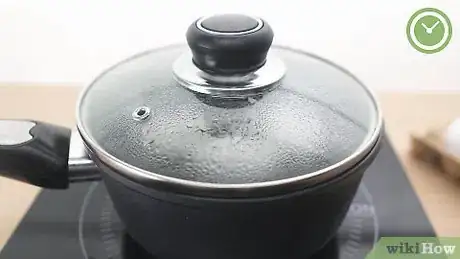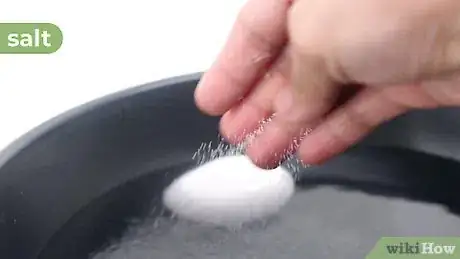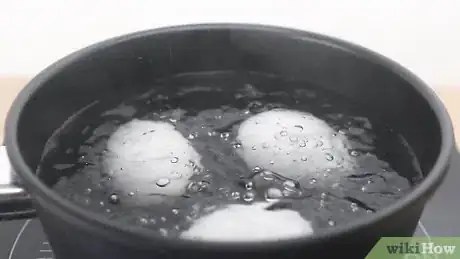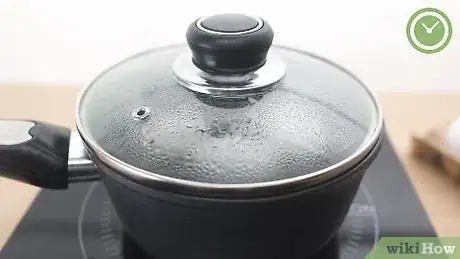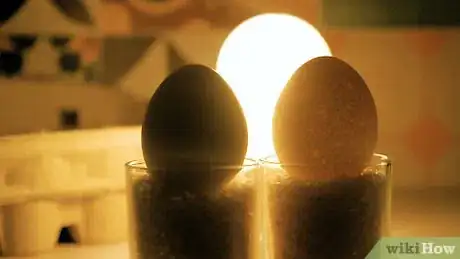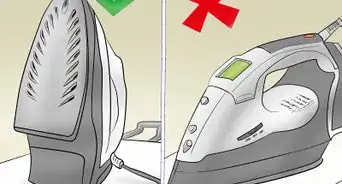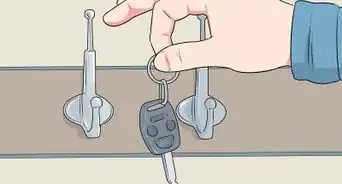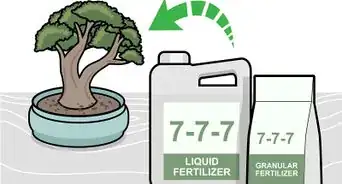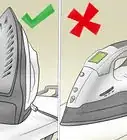This article was co-authored by Ollie George Cigliano. Ollie George Cigliano is a Private Chef, Food Educator, and Owner of Ollie George Cooks, based in Long Beach, California. With over 20 years of experience, she specializes in utilizing fresh, fun ingredients and mixing traditional and innovative cooking techniques. Ollie George holds a BA in Comparative Literature from The University of California, Berkeley, and a Nutrition and Healthy Living Certificate from eCornell University.
wikiHow marks an article as reader-approved once it receives enough positive feedback. This article has 15 testimonials from our readers, earning it our reader-approved status.
This article has been viewed 553,177 times.
Boiled eggs make wonderful additions to breakfast or lunch, and can be used in deviled eggs or all sorts of other snacks. Because a raw egg and a boiled egg look just the same, however, it can be difficult to know when an egg is finished cooking. If you're unsure, you can learn a few simple procedures to make sure you cook them properly each time, and how to quickly distinguish between a raw egg and a cooked egg. See Step 1 for more information.
Steps
Boiling Eggs Properly
-
1Cover raw eggs with cold water. Take however many raw eggs you want to boil and put them in a heavy-bottomed pot. Gently, fill the pot with cold water, taking care not to jostle the delicate eggshells too much. Use enough to cover the eggs by about an inch. Put the pot, uncovered, over medium-high heat and bring it to a boil.[1]
- Never add raw eggs to boiling water. Boiling the water first results in the most inconsistent cooking process, often ending with broken shells, leaky eggs, and greenish yolks. Bringing the eggs up to temperature slowly ensures even cooking.
-
2Turn off the heat as soon as the water boils. Depending on how you want your eggs cooked, you can remove the egg at different times in the process, but the easiest to remember and the most sure way to cook eggs, however, is to remove the pot from the heat just after it reaches a boil and leave the eggs in the water until the water cools. Boiled this way, you can be confident the eggs are hard-boiled and solid:
- Add eggs to cool water and heat to boiling over medium-high heat
- Remove the water from the heat as soon as it boils
- Cover the pot with a lid
- Let the eggs sit for 15 minutes, or until the water becomes cool enough to dip a finger in
-
3Watch the clock for more specific yolks. If you want a softer-boiled egg, or you want to eat more quickly, you can remove the eggs from the simmering water after a variable amount of time has elapsed. If you want to do this, turn the heat down slightly, to about medium, when the water reaches a boil, and start watching the clock.[2]
- For soft-boiled eggs, remove after 2 minutes. The whites should be cooked thoroughly, and the yolks should still be somewhat runny. Rinse immediately in cold water to stop the cooking process, or they'll become quickly over-done.
- For medium-boiled eggs, remove after 4 1/2 minutes. The yolks of medium-eggs should be just about solid, but moist, more like a custard than a hard-cooked egg.
- For hard-boiled eggs, remove after 8 minutes. The yolks of hard-boiled eggs are crumbly and bright yellow, completely solid, but with none of the grayish-green around the yolk that over-cooking yields.
-
4Consider adding salt or vinegar to the water. It's a common misconception that adding salt to water will raise the boiling point and result in a more uniform boil, or will make the egg easier to peel. It is true, however, that adding salt will season the water, affecting the flavor (even in hard boiled eggs), but you'd need to add an irrational amount of salt (about a half-cup) to raise the temperature even a few degrees.[3]
- Adding about a teaspoon of vinegar, however, will help to keep the white intact, should the shell crack any during the boiling process, without affecting the flavor significantly. Consider adding a small amount to keep your eggs solid.
-
5Simmer, don't boil. Greenish or grayish rings around the yolk are a telltale sign that you've boiled the egg either at too-high a temperature, possibly by dropping it directly into boiling water, or that you cooked it for too long. To avoid this, don't cook eggs at a rolling boil, but turn it down to about medium temperature, cooking them at a quick simmer. There should still be bubbles, but not so many that the eggs jostle around and rattle the pot.[4]
- The green-gray color results from iron in the egg yolk interacting with sulphur in the white, and only happens when they react at high temperature. You'll never reach that high temperature if you bring the eggs up gradually and remove them from the heat in time.[5]
-
6Use the slow cool-down if you lost track of time. If you added your eggs to boiling water, or haven't been watching the clock, don't fear. Make sure they've been in the water for at least 5 minutes, and them cover the pot and remove them from the heat. Wait 10 minutes and they'll be done every time.
Testing the Eggs
-
1Spin the egg. The quickest way to distinguish between an uncooked egg and a solid boiled egg is to put it flat on the counter and spin it. A raw egg will wobble and spin slowly, because it's filled with liquid, while a boiled egg will spin very quickly and very easily.[6]
- Try this now by getting out a raw egg and trying to spin it like a top, on the flat side of the shell. Compare that to an egg you know is done and you'll have an easy quick test to distinguish between them every time.
-
2Hold the egg up to the light. Another easy way to distinguish between uncooked eggs and solid eggs is to hold it up to the light. The thin shell of a raw egg should let some light through, and you'll be able to see the yolk on the inside. A boiled egg will be completely solid.
- Use a flashlight on the other side of the egg and shine it toward you, holding the egg between the light and your eyes. Move it back and forth slightly while you look for the yolk.
-
3Drop the egg in warm water and look for bubbles. If an egg is raw, tiny air bubbles will rise from the shell as soon as its submerged in water. If it's in the warm boil, it'll be hard to tell because the water itself will be bubbling. But keeping an eye on the bubbles that rise from the egg itself is a good fast way to tell whether the egg is raw or cooked.
-
4Crack it open, if all else fails. If you're boiling multiple eggs and you're still not sure how to figure out whether or not they're done, take one out, run it under water, and crack it open quickly to check. Cut it in half and examine the yolk. If it's where you want it to be, take the rest of the eggs out. If not, leave them in for another few minutes. You'll only have sacrificed one and you won't be wondering.
Expert Q&A
-
QuestionWhat does a bad egg look like?
 Ollie George CiglianoOllie George Cigliano is a Private Chef, Food Educator, and Owner of Ollie George Cooks, based in Long Beach, California. With over 20 years of experience, she specializes in utilizing fresh, fun ingredients and mixing traditional and innovative cooking techniques. Ollie George holds a BA in Comparative Literature from The University of California, Berkeley, and a Nutrition and Healthy Living Certificate from eCornell University.
Ollie George CiglianoOllie George Cigliano is a Private Chef, Food Educator, and Owner of Ollie George Cooks, based in Long Beach, California. With over 20 years of experience, she specializes in utilizing fresh, fun ingredients and mixing traditional and innovative cooking techniques. Ollie George holds a BA in Comparative Literature from The University of California, Berkeley, and a Nutrition and Healthy Living Certificate from eCornell University.
Private Chef & Food Educator Fill a bowl with cool water and place the eggs into the water. If they float, they are bad and should be discarded. The ones in the bottom are good. If you are worried you won”t be able to tell or that some might be in the middle, have no fear: some eggs will not lay on their side at the bottom “fresh zone”, and kind of nod up, but still stay at the bottom. These are about a week old, but still good.
Fill a bowl with cool water and place the eggs into the water. If they float, they are bad and should be discarded. The ones in the bottom are good. If you are worried you won”t be able to tell or that some might be in the middle, have no fear: some eggs will not lay on their side at the bottom “fresh zone”, and kind of nod up, but still stay at the bottom. These are about a week old, but still good. -
QuestionWhat is the easiest way to remove the egg shells after boiling?
 Community AnswerWhen the egg is still warm, pat or roll the egg on a countertop. Starting at one end, peel in a circular motion.
Community AnswerWhen the egg is still warm, pat or roll the egg on a countertop. Starting at one end, peel in a circular motion. -
QuestionWhy would an egg rise to top of pot while it is being boiled?
 Community AnswerIf an egg floats to the top at any point, it means the egg has gone bad and you should discard it.
Community AnswerIf an egg floats to the top at any point, it means the egg has gone bad and you should discard it.
References
- ↑ https://www.exploratorium.edu/cooking/eggs/explore-text.html
- ↑ https://www.deliciousmeetshealthy.com/how-to-make-perfect-hard-boiled-eggs/
- ↑ http://www.simplyrecipes.com/recipes/how_to_make_perfect_hard_boiled_eggs/
- ↑ https://whatscookingamerica.net/Information/PoachingSimmeringBoiling.htm
- ↑ https://www.incredibleegg.org/cooking-school/tips-tricks/why-eggs-turn-green/
- ↑ https://www.cookinglight.com/cooking-101/egg-test-boiled
About this article
To tell when an egg is boiled, try spinning it on a flat surface. If the egg wobbles and spins slowly, it means there's still liquid inside, but if it spins quickly and easily, it's most likely boiled. You can also hold the egg up to a light to see if it's boiled. If you're able to see the yolk inside, the egg is still raw, but if the egg looks completely solid, it's probably boiled. Or, you can put the egg in some warm water and see if tiny air bubbles rise from the shell, which is a sign that the egg is still raw. To learn how to boil an egg properly, keep reading!

